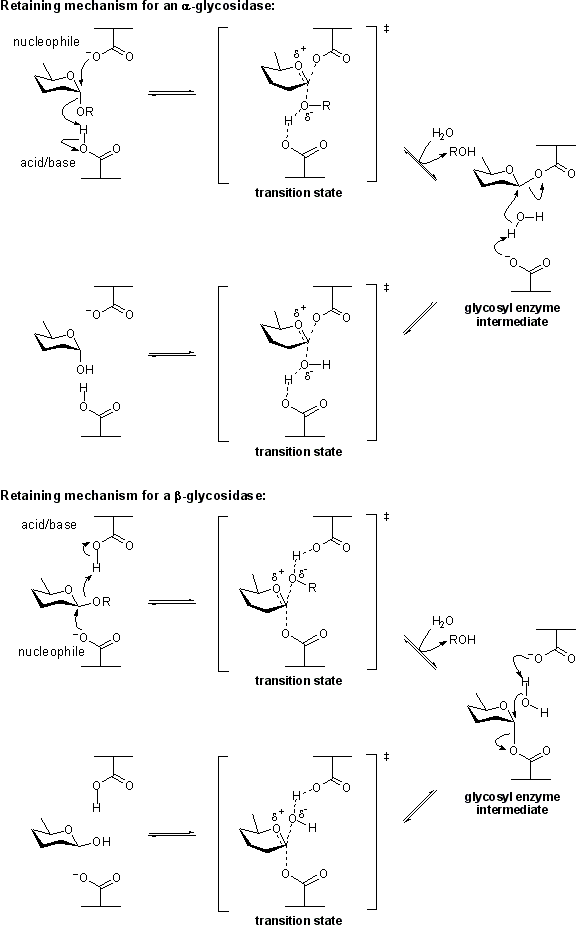CAZypedia needs your help! We have many unassigned GH, PL, CE, AA, GT, and CBM pages in need of Authors and Responsible Curators.
Scientists at all career stages, including students, are welcome to contribute to CAZypedia. Read more here, and in the 10th anniversary article in Glycobiology.
New to the CAZy classification? Read this first.
*
Consider attending the 15th Carbohydrate Bioengineering Meeting in Ghent, 5-8 May 2024.
Catalytic nucleophile
- Author: Spencer Williams
- Responsible Curator: Spencer Williams
Overview
The term catalytic nucleophile refers to an amino acid residue in a glycoside hydrolase. The residue participates in the classical Koshland retaining mechanism. In summary, hydrolysis occurs with net retention of configuration through a two step, double-displacement mechanism involving a covalent glycosyl-enzyme intermediate. The reaction occurs with acid/base assistance provided by another amino acid side chain. In the first step (often called the glycosylation step), the catalytic nucleophile plays the role of a nucleophile, attacking the anomeric centre to displace the aglycon and form a glycosyl enzyme intermediate. At the same time the other residue functions as an acid catalyst and protonates the glycosidic oxygen as the bond cleaves. In the second step (known as the deglycosylation step), the glycosyl enzyme is hydrolyzed by water, with the other residue now acting as a base catalyst deprotonating the water molecule as it attacks. At the completion of the catalytic cycle the catalytic nucleophile is restored.
Methods for indentifying the catalytic nucleophile
The main methods for assigning a particular amino acid with the function of a catlytic nucleophile is either by labelling with a mechanism-based inhibitor, or through kinetic analysis of mutants. In the absence of these data, X-ray crystallography, especially of substrate or transition state analogues, may provide clues towards the identity of the catalytic nucleophile.
Kinetic analysis of mutants
Assignment of the catalytic nucleophile may be achieved by the kinetic analysis of enzyme mutants in which the candidate residues have been replaced by a non-nucleophilic residue. Alanine is preferred as a replacement residue owing to its small size. Glycine is non-optimal, as the lack of an alpha-substituent may lead to differences in conformation. Based on empirical observations, nucleophile mutants typically give kcat values 10,000-fold lower than the wildtype enzyme. A second kinetic test for the nature of the nucleophile is the observation of a 'chemical rescue'. When supplied with a glycoside with a good leaving group, such as 2,4-dintrophenyl, such 'activated' glycosides may exhibit an increased rate of turnover in the presence of small anionic nucleophiles such as azide, fluoride or formate. In this case the product of 'chemical rescue' should be a glycosyl azide, fluoride or formate with inverted anomeric stereochemistry.
